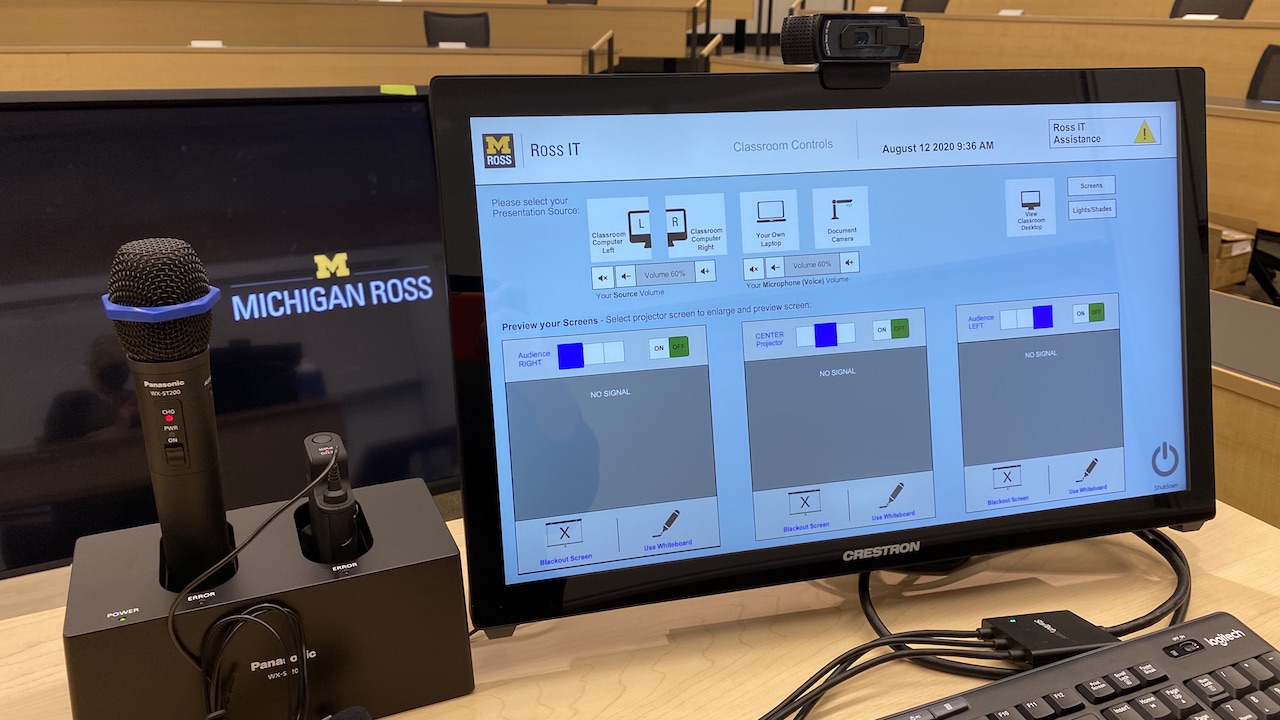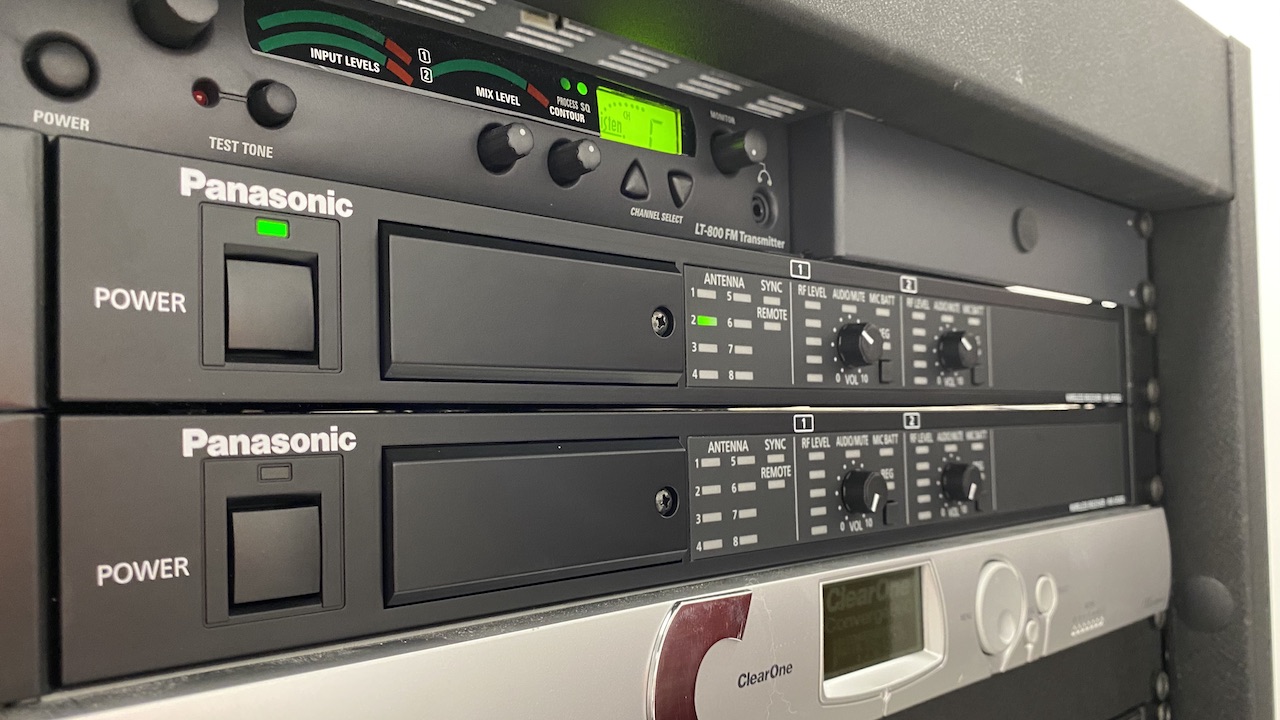U of Michigan Boosts HyFlex Learning Audio with Panasonic Wireless Mic System

University of Michigan’s Stephen M. Ross School of Business is a top-ranked business school worldwide, offering action-based learning to prepare graduates for an ever-evolving world. Today, that includes overcoming technical challenges in instruction.
Christopher Visel, director of AV infrastructure at the school, was already looking to upgrade the wireless microphones in their classrooms before the COVID-19 pandemic. “Our microphone system was about 10 years old and the RF spectrum it operated on was phased out by the FCC, so it was time for an upgrade,” he said. “I was looking for a wireless mic solution that used a frequency spectrum that would be a better long-term solution. Our classrooms, particularly in our Ross Building, are adjacent to each other and on top of each other. Because the building is several stories, we were concerned about crosstalk and interference, which was a problem with our old system. It also had to be easy for faculty to use and for our IT department to support. After testing Panasonic’s Digital Wireless Microphone system at our facility for several months, it was clear the Panasonic system was the right choice.”
Related: The Technology Manager's Guide to Audio in the New Era of UC
Visel reached out to integration partner TEL Systems, which specified Panasonic’s Digital Wireless Microphone System that uses DECT 1.9GHz technology for a stable and secure communication from each wireless microphone to the receiver.
“The system features a distributed architecture allowing us to rackmount the receivers in locked cabinets outside of the classroom,” said Paul Eiswerth, vice president for TEL Systems. “This leaves just the wireless microphones, wireless bodypacks, and the antennas inside the room. It is incredibly easy to install and the wireless microphones are pair-registered to the Panasonic receivers, so there is no need to manually channel plan and assign.”
According to Visel, professors prefer wireless bodypacks and lavalier microphones because they keep their hands free to use their computer and write on the whiteboard. “Panasonic’s wireless bodypacks are among the lightest in the industry (less than 0.25 pounds with the battery inserted), so they liked that when we tested Panasonic versus other competitive offerings,” he said. Each Panasonic wireless handheld microphone or wireless bodypack takes only one AA battery (standard or rechargeable Ni-MH). Desktop charging consoles are in each room to recharge the handheld mics and wireless bodypacks when not in use.

“Another feature of Panasonic’s digital wireless microphone system is that both the wireless microphone and wireless bodypack feature a 3.5mm audio input,” Visel said. “Professors and students that are using the classroom and want to play audio from their laptop or smartphone can easily do so by plugging a 3.5mm cable from their device into the handheld or bodypack.
A daily selection of features, industry news, and analysis for AV/IT professionals. Sign up below.
Visel and his team were also able to leverage previously owned 80-inch displays from collaboration classrooms and distribute them to each classroom where they are installed onto a custom fabricated stand for displaying a “Zoom gallery.” Lecture desks are motorized for adjustable height and have Crestron touchpanels that serve as room control as well as double as confidence monitors. The rooms have occupancy sensors that automatically wake up the Crestron touchpanel and turn on the lights when the professor walks in the room. Professors can control the volume levels on the Panasonic microphones from the Crestron touchpanel and can see the audio level as well as the battery level status. Professors can choose to bring their own laptop for presentation or insert a USB thumb drive into the computer locked in the desk. University of Michigan has standardized on Zoom for online education.
Another challenge the Michigan Ross IT team had to overcome with a hybrid in-person / virtual class was how to facilitate natural dialog between students and the teacher. To accomplish this, Visel mounted three ceiling microphones, later adding a fourth to capture speech near teacher’s desk, and one microphone over the teacher’s desk in the room and ran them into a Biamp Tesira Digital Signal Processor (DSP), as well as a line out from the Panasonic digital wireless microphone system. This put priority on the Panasonic lavalier microphone so that the teacher could always be heard. The Panasonic receivers are wired directly to the Tesira DSP, and the line out is from Tesira to PC.
Phase 1 deployment of the Panasonic wireless mic system includes 22 classrooms in the Ross, Wyly, and Blau buildings at the University of Michigan Ross School of Business. Two classrooms in the Blau and Ross building have room dividers that have been eliminated due to social distancing requirements. The University wanted to accommodate a future when they could be divided, so multiple wireless receivers and antennas were installed to accommodate one large room or two smaller ones.
“This was a fun project to work on,” Eiswerth said, “mainly because Panasonic worked as a team with us and the IT team at Michigan Ross School of Business. Sometimes projects like this when the manufacturer is heavily involved can get a little antagonistic, but Panasonic delighted us with their superior service and support.”
“We’re very happy with the audio quality of the Panasonic digital wireless mic system,” Visel said. “With our new classroom designs, we are well-prepared for whatever comes our way.”
The AVNetwork staff are storytellers focused on the professional audiovisual and technology industry. Their mission is to keep readers up-to-date on the latest AV/IT industry and product news, emerging trends, and inspiring installations.
